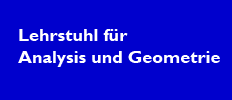


|

|
|||
|
|
||||
|
|
|
|
||||||||||||||||||||||||
Einführung in die konforme Feldtheorie
|
| Titel: | Einführung in die konforme Feldtheorie |
| Dozent(in): | Prof. Dr. Katrin Wendland, Dr. Manfred Herbst |
| Termin: | Dienstags: 08:15 - 09:45 Uhr, Mittwochs: 10:00 - 11:30 Uhr |
| Gebäude/Raum: | jeweils Geb. L1 / 1007 |
| Ansprechpartner: | Prof. Dr. Katrin Wendland Dr. Manfred Herbst |
From a physicists' point of view, there are many reasons to study conformal field theory, like its applications in statistical mechanics, solid state physics and integrable systems. In string theory, the modern so far speculative attempt to unify the forces of Nature, CFTs describe possible string vacua. On the other hand, conformal field theory has developed to tempting mathematical beauty; its mathematical applications range from finite group theory over infinite-dimensional Lie algebras to parts of topology, modular forms, and algebraic geometry.
In 1998, R.E. Borcherds was awarded a fields medal for his work in automorphic forms and mathematical physics, where he in particular made use of conformal field theory. However, Borcherds is known to have said that either you know what CFTs are or you don't want to know. This statement must be viewed as a reaction to the current state of introductory literature, which can be particularly confusing from a mathematician's point of view.
This course is meant to give a digestible mathematical introduction to conformal field theory, assuming no background knowledge from quantum field theory. The aim is to motivate and explain the relevant terminology and in particular to discuss fundamental examples of CFTs in detail. This should enable the student to work with the existing literature by the end of the course. More specifically, we will construct the simplest examples of CFTs and study their properties, thereby motivating axiomatic approaches to CFT.
The course will be taught either in English or in German, depending on the audience.
| empfohlenes Studiensemester der Lehrveranstaltung: | ab dem 5. Semester |
| Fachrichtung Lehrveranstaltung: | Mathematik, Physik |
| Nummer der Lehrveranstaltung: | 0 |
| Dauer der Lehrveranstaltung: | 4 SWS |
| Typ der Lehrveranstaltung: | V - Vorlesung |
| Leistungspunkte: | 10 LP für Vorlesung und Übung |
| Semester: | WS 2009/10 |
|
|